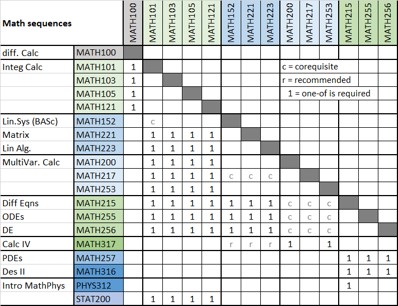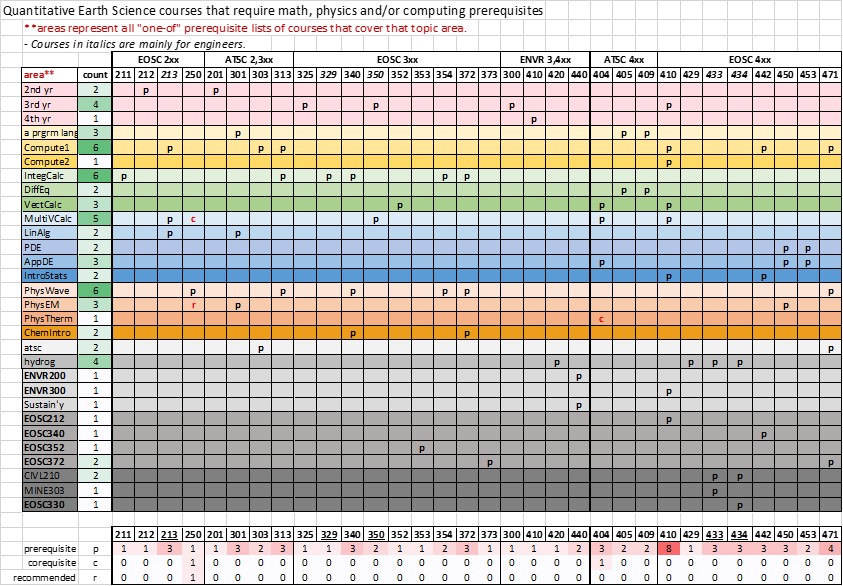Curriculum maps for QES courses
Many courses offered by our department (course codes EOSC, ATSC, ENVR) involve developing quantitative skills. however the 34 courses in the course dependencies maps (next figure) are the main focus of the QuEST project. They are the courses that emphasize, or use, advanced mathematics (beyond first year calculus), physics or computing. Click here to explore the four interactive maps on the EOAS website. The goal of this resource is to help visualize and explore the dependencies between quantitative EOAS courses, and all prerequisite courses required for these 2nd, 3rd, and 4th year EOAS courses. Instructions are included for using and building these types of interactive pages.
The goal of this resource is to help visualize and explore the dependencies between quantitative EOAS courses, and all prerequisite courses required for these 2nd, 3rd, and 4th year EOAS courses. Instructions are included for using and building these types of interactive pages.
Observations based on QES curriculum maps
The following observations are about the official dependencies between courses. Aspects of curriculum not addressed here are those related to specific learning goals, topics, the needs of employers and interests or priorities of students.
Reasons for reviewing official prerequisite dependencies include:
- formal prerequisite requirements are the strongest indicator of curricular flow, so it is worth examining how courses depend on each other.
- identifying courses that assume no prerequisite quantitative capabilities, and to then consider whether that is appropriate, and why;
- finding courses that other courses do not depend upon – especially if they are in 1st or 2nd year. These may represent lost opportunities for more senior courses to benefit from prior knowledge that students will gain in an that earlier course. Or they may suggest courses that are contributing less than they could to students’ success. This situation also suggests to students that capabilities gained are “less important” because they are never used again within their degree’s curriculum;
- identifying courses that accept more than one prerequisite and consider whether the alternatives are in fact providing equivalent prior capabilities;
- reflecting on whether a given course actually does make use of the current prerequisites;
- Informal relationships certainly exist between courses but these are not considered here as they are more a matter of individual instructors’ decisions.
General observations & questions
Many instances of “implied prerequisites” exist in the form of curricular requirements. As one example, EOSC211 is required for 2nd year geophysics students but not a prerequisite for EOSC354 (time series analysis) in which students carry out significant computing.
Therefore, explicit prerequisites could be considered less important for courses taken only by students in specific specializations because degree requirements specify the courses that are necessary. For courses available to students outside of EOAS, prerequisites are more important since instructors can’t count on “assumed” capabilities learned in previous courses.
“Corequisites” are only mentioned twice, once for EOSC250 and once for ATSC404. Are those requirements working as planned?
200-level courses
- EOSC213 is not required by any other course in EOAS, and only as “one of” 3, for CIVL417. See “dependent courses” near end of this page.
- EOSC211 and DSCI100. These are both “first exposure to programming”, although DSCI100 is more fundamentally a statistics course, while EOSC211 is introductory programming in an Earth sciences context.
- Only four EOAS courses taken by B.Sc. EOAS students require EOSC211. However, the course is required by some programs, so students will have taken it (or equivalent) weather it is a formal prerequisite or not.
- For any course requiring EOSC211, should DSCI100 count too? Currently, ATSC313 is the only EOAS course with DSCI100 as a “one-of” prerequisite.
- However, DSCI100 does fill a need with respect to exposure to elementary statistics.
- Geophysics has included DSCI100 in required courses (or, with permission, another 2xx statistics course). Other EOAS programs do not DSCI100. This gives geophysics students an advantage regarding programming skills when they take EOSC211, yet they are likely the students least in need of it. Does this increase the bimodal nature of student success in EOSC211? Maybe geophysics should require either DSCI100 or EOSC211?
- Student feedback from Dawson club members, reported March 11, 2022: “significant proportion of the class gets lost very soon and never really gets it. Peers attempt to support but often without seeing any breakthrough in understanding”. Details not conveyed, but dissatisfaction seems fairly widespread.
- EOSC250:
- What in MATH200 as coreq is important? Or – why not make it a prerequisite (or MATH253) like EOSC213?
- Are there opportunities for employing computing either as part of problem-solving or (perhaps more appropriately) for introducing interactive concept demonstrations, and contexts that are easily identifiable as “important” rather than “scientifically interesting”. This is about motivation as the course leaves a rather “dry” and “unattractive” public-facing impression.
- EOSC212 is not required by any EOAS courses.
- However, it is required by geophysics (212 or a 1xx +111), geology and EOS degrees.
- Perhaps there could be at least one “module” in which “scientific thinking” (the course’s theme) is incorporated into an industry or commercial?
- ATSC212, EOSC256, EOSC355; are these “redundant”? Should they be deleted from the UBC calendar?
300-level courses
- At 3rd year level, only ATSC303 and ATSC313 have any explicit computing prerequisites. Not even EOSC211 or DSCI100 are required for any other 300-level QES courses. However, requirements are implicit in degree specifications.
- Re. EOSC354
- There are no computing prerequisites. Geophysics students will have taken EOSC211 so this is not a “problem” for them. However more students might be attracted if it is recognized as a course in which students continue to grow their computing skills.
- Could a Calc1 prerequisite be swapped out in favour of “EOSC211 or equivalent”? After all, EOSC211 itself requires Calc1.
- Augment the “either/or” physics prerequisites for EOSC354 by adding PHYS153 & PHYS106.
- EOSC353
- EOSC354 not prerequisite for EOSC353, presumably to increase the potential for non-geophysics students to take 353 (seismology). But if 353 does not depend on time series, maybe it should?
- Adjust to attract more students: Offer alternate years? Rename to have broader appeal? “Advertise” in Phas/Astron or Civil Eng (eg grads)?
- Could ATSC303 have more options for computing prereqs? Currently EOSC211 alone is required.
- Add SCIE001 to any requirements for Calc1 (three 3rd yr courses) or Physics101 (eg EOSC250).
- ATSC313: augment options for the physics requirement by allowing PHYS153 & 106?
400-level courses
- Two ATSC and two geophysics 4xx courses require no EOAS prerequisites. This possibly helps attract students from other disciplines, but means there is no certainty about student capabilities coming into the course.
- EOSC410 seems quite restrictive to undergrads (and taken by only ~4-8). See Questions below.
- The “any programming language” for ATSC405, 409 is vague. Is that OK?
- Do EOSC 45x really need no computing, or are capabilities assumed owing to 4th yr status in science?
- Consider having 4xx “specialist” courses include at least some “either or” prerequisites from EOAS, eg ATSC405, 406 and EOSC450, 453.
- ATSC405: augment Diff Eqns requirement by allowing MATH255 or 256?
- ATSC404: augment Applied DEs requirement by allowing MATH257?
- EOSC410:
- augment stats requirement to include STAT201 or 251?
- augment cmpsc requirement to include five courses in “pink” box?
- EOSC410 seems quite restrictive to undergrads (and taken by only ~4-8 students).
- Is EOSC212 or ENVR300 necessary if “3rd yr in EOAS is included?
- Is that requirement even necessary? (Probably – but worth discussing because students outside EOAS might be attracted).
- Could single requirement of eosc211 be loosened? Especially if CPSC203 and 210 are required.
- In fact, are CPSC203 and 210 really required?
- EOSC471: augment requirement to include five courses in “pink” box?
- Are ATSC405, 406 “redundant”? Should they be deleted?
Prerequisite competencies
Prerequisite competencies (not courses) are listed here for only the quantitative courses in EOAS (not all EOAS courses). Click the image for a full size version in a new tab.
Comments regarding prerequisite competencies
- The most commonly needed prerequisite capabilities are (number of EOAS courses depending on each prerequisite subject area is in column 2. )
- First course in computing/programming (6 courses need this),
- First year integral & differential calculus (6 courses need this).
- multivariate calculus (5 courses need this),
- wave physics (6 courses need this).
- The number of prerequisite subject areas (not specific courses) prior to taking each EOAS course is in the bottom 3 rows.
- EOSC 410 (cross-listed with EOSC 510 for grad students) has prerequisites in 8 subject areas or courses, which seems difficult to achieve for undergrads. In fact there are usually only 4-8 undergrads enrolled.
- One challenge is that EOAS courses are often electives for other programs and a balance must be found between asking for highly “prepared” capabilities (lots of prerequisites) and accessibility of these courses to a wide range of students.
- The “chain of math” prerequisites via the next figure. Course in cols 1,2 need courses identified in columns 3-16. The 1’s indicates “one-of” is the requirement.

(This could be redrafted as a sequence tree and physics could be added.) - Advising: students see a variety of courses for each subject area (such as “integral calculus”). They should choose the correct option for their degree specialization and ensure that courses are taken in the right sequence. Therefore, well-informed advising is important, and the correct academic calendar needs to be followed carefully. (Further details under Student Support.)
- Detailing math needs: For EOAS courses, math dependencies need more rigorous review by mapping actual content in EOAS courses identifying how the math prerequisite knowledge is relevant. This could be “by implication” as developing mathematical “maturity” is important, but clarifying how early math courses impact capabilities for later EOAS courses should be part of a curriculum review process.

